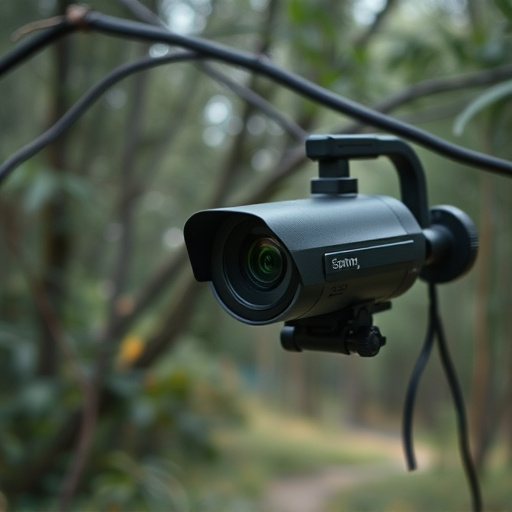In today's digital era, advanced spy cameras equipped with cloud storage capabilities have become a significant privacy concern. These devices transmit data signals that can be detected using specialized equipment and software, revealing their presence and location through electromagnetic emissions analysis. By targeting these signals, experts can successfully locate hidden cameras linked to central cloud servers, revolutionizing surveillance tactics. To combat this evolving threat, users should employ specialized detectors, stay informed about detection techniques, and be aware of common placement spots for proactive search and enhanced privacy and security.
Uncover the insidious world of surveillance devices with our comprehensive guide to electromagnetic signal detection. Learn to identify hidden threats like spy cameras, understanding the basic principles of electromagnetic signals and their unique signatures. Discover advanced techniques for on-site detection and explore the role of cloud storage in tracking these devices. By mastering these tips, you’ll be equipped to navigate today’s digital landscape, ensuring your privacy is safeguarded from clandestine spy camera operations.
- Understanding Electromagnetic Signals: The Basics
- Identifying Spy Cameras Using Signal Detection
- Cloud Storage and Its Role in Surveillance Device Detection
- Advanced Tips for Effective Spy Camera Detection
Understanding Electromagnetic Signals: The Basics
Electromagnetic signals are an essential aspect of modern technology, often invisible yet all-pervading. These signals are a form of energy that travels through space and can be generated by various devices we use daily, from mobile phones to Wi-Fi routers. When it comes to surveillance, understanding electromagnetic signals is crucial for detecting hidden cameras or tracking devices.
In the context of spy cameras with cloud storage, these signals can leak valuable information about their presence. For instance, some advanced devices may emit unique electromagnetic signatures that can be picked up by specialized detectors. Cloud-based storage further complicates matters as these cameras often sync data wirelessly, leaving digital traces that might be traceable back to the device’s origin.
Identifying Spy Cameras Using Signal Detection
Identifying hidden spy cameras has become a crucial skill in today’s digital age, where privacy breaches can often be facilitated by advanced surveillance devices. One effective method for detection is through signal analysis, particularly when dealing with spy cameras equipped with cloud storage capabilities. These devices transmit data signals that can be picked up using specialized equipment, providing valuable insights into their presence and location.
By employing signal detection techniques, users can uncover hidden camera feeds that might otherwise go unnoticed. This process involves scanning for unusual electromagnetic emissions, which are often characteristic of spy cameras transmitting video or audio data to remote servers. With the help of advanced software and sensors, it is possible to track these signals, leading to the discovery of covert surveillance devices, especially those utilizing cloud storage for extended monitoring sessions.
Cloud Storage and Its Role in Surveillance Device Detection
In today’s digital age, surveillance devices equipped with cloud storage have become increasingly prevalent. These spy cameras, hidden in plain sight, utilize cloud-based systems to record and store vast amounts of data, making their detection a complex task. Cloud storage serves as an invisible yet powerful tool for tracking these devices, as it allows for remote access and real-time monitoring.
By analyzing the electromagnetic signals emitted by surveillance equipment, experts can identify unique patterns associated with cloud-connected devices. This involves detecting specific frequency ranges and data transfer protocols that are characteristic of cloud communication. With advanced signal processing techniques, it becomes possible to pinpoint the location of these hidden cameras, especially when they are linked to a central cloud storage server.
Advanced Tips for Effective Spy Camera Detection
In the realm of surveillance device detection, particularly for advanced spy cameras with cloud storage capabilities, users must stay ahead of evolving technology. One effective tip is to employ specialized detectors designed to identify electromagnetic signals—a signature often left by hidden cameras. These devices can pinpoint sources of radio frequency emissions, helping you uncover covert recording devices.
Additionally, staying informed about common hiding spots and keeping up with the latest detection techniques is vital. Spy cameras are known to be discreetly placed in everyday objects like clocks, light switches, or even door handles. By understanding these strategies, individuals can proactively search for potential spy cameras and ensure their privacy, especially when dealing with devices that sync data to cloud storage for remote access.
In conclusion, understanding electromagnetic signals and leveraging cloud storage are crucial tips in navigating the modern landscape of surveillance device detection. By familiarizing yourself with signal basics and advanced techniques, you can effectively identify hidden spy cameras, including those utilizing cloud storage for covert data transmission. Stay vigilant and proactive to protect your privacy in today’s digital era.
